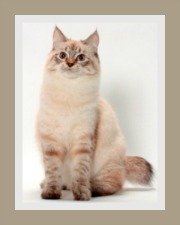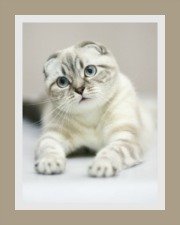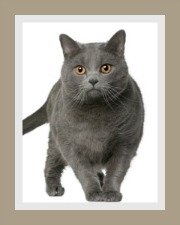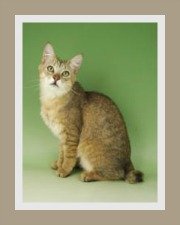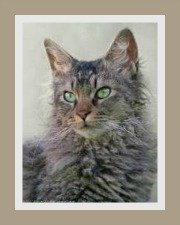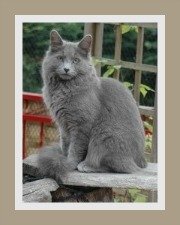Persian Cat
Breed Profile and Cat Facts
The Persian cat is a longhaired cat breed and certainly not a cat for cat lovers who have no time for grooming.
This gorgeous cat needs lots of pampering, but remains one of the
most popular breeds in the world.
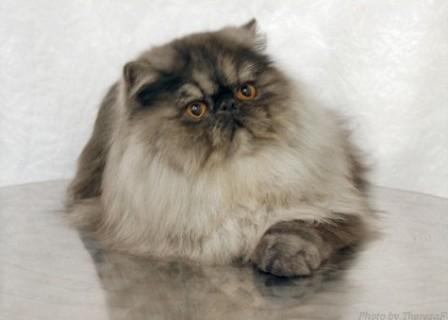
L'Exquisite Apres Midi | Black smoke Persian female | owned and bred by Brenda Neukircher | © Theresa Fouche
When we think Persian kitties, we think of long flowing fur, large round eyes, adorable flattened faces, chubby cheeks and a distinctive snub nose.
This is a medium-to-large, sturdy and strong cat with a toned muscular body that is well proportioned. The word cobby comes to mind!
The torso is set low on its legs, the latter being short, but well developed and strong.
That glorious furry tail is straight and generally shorter than the body and always carried low to the ground.
a glorious coat
The fur is soft, silky thick, luxurious, dense and usually stands away from the body. Naturally, a dense coat will require extensive grooming.
Now, if you're a 'color-junky' then this cat aims to please!
This longhaired cat breed comes in a wide range of colors and patterns from pitch-black cats to snow-white Persians and all those colors in between. Take a look at the Persian cat color examples.
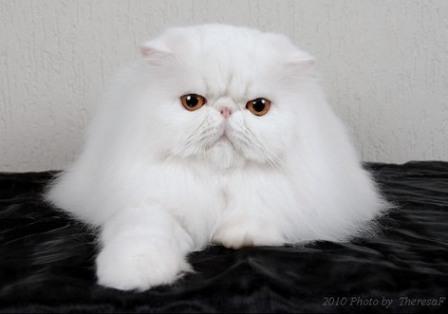
Cracker Oscar Nominee | Copper-eyed white Persian male neuter | Owner René van Wyk Breeders P Williams A Visser | Persian picture © Theresa Fouche
persian features
The eyes are a sight to behold! Large, round eyes set wide apart with colors to match their magnificent coats.
Eye-color varies dependent on coat color, but colors you can expect to see are clear deep blue, emerald or blue-green, orange to copper and hazel and then of course the highly sought after odd-eye of one copper and one blue eye.
The Persian's ears are small, with rounded tips and set wide apart. The ears are low on the head and fit into the contour of the head.
It is interesting to note that the breed standard for the nose varies. CFA (Cat Fanciers' Association) / TICA (The International Cat Association) calls for a short, snub and broad nose with the 'break' that is centered between the eyes. The nose, forehead and chin should be in vertical alignment.
The GCCF (Governing Council of the Cat Fancy) breed standard requires a 'short, broad nose with stop'.
In both cases the nostrils need to be open and not constricted.
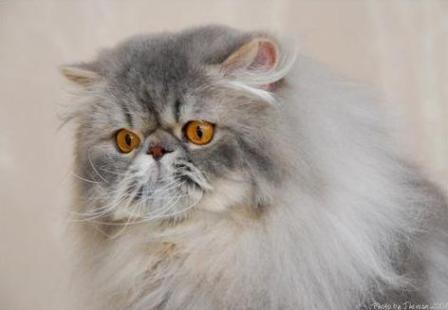
Sp Ch LExquisite CEstSiBon | Owner D Viviers and C Danziger bred by Brenda Neukircher | Persian picture © Theresa Fouche
info for potential persian cat owners
ideal home | ideal family
Persians do adapt well to apartment living and tolerate solitude provided it's not for extended periods. The pampered Persian prefers a tranquil environment.
It is recommended that it is kept indoors because of its coat maintenance (and for safety reasons).
However, like all cats, they do love the freedom of an enclosed, escape-proof and safe garden.
Persians make ideal pets for families, couples and singles as they are equally happy being part of a family as they are with their own company.
This cat makes a wonderful companion, but it prefers gentle children and needs to be pampered.
The Persian does enjoy the company of docile and relaxed cat-friendly dogs.
persian personality and temperament
They've got purrsonality! Yup it's in the genes. Breeding has a lot to do with the character of any cat.
These stunning cats are renowned for their even temperament.
The owners we spoke to described them as adorable and placid and most of all laid back and calm.
They are loving and sociable, calm and affectionate. They can be playful, but prefer gentle play. They love games as much as any other cat, but they are not highly active cats and soon bore of games.
Persian kitties are quiet and undemanding of your attention.
They generally take time to warm to strangers (who doesn't) - but they are generally very sociable and love to be the center of attention.
With their owners they tend to be talkative, but never overly vocal.
When you've bonded with your Persian cat, its eyes will often communicate more than words (or should I say meows) ever would.
persian grooming and cat care
This is a high maintenance cat breed. If you do not have the time for daily brushing and daily eye care, we do suggest an alternative cat breed.
Daily grooming takes about 15 minutes, but these stunning cats are well worth the effort! Neglect of the coat and eyes can lead to problems.
cat hair care - great tips and advice for grooming your longhaired cat
cat eye care - valuable information about cleaning your cat's eyes
cat dental care - cleaning your cat's teeth
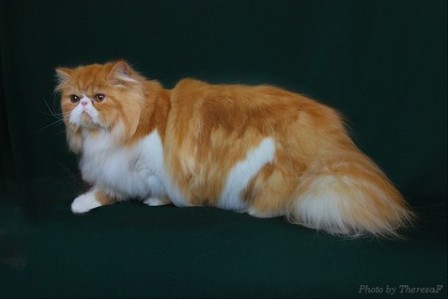
ChaCha Fire Lilly | owner Charmaine Turner | Persian picture © Theresa Fouche
persian health concerns
Generally the Persian cat is a healthy cat breed, but some breeding lines are prone to:
- PKD (polycystic kidney disease)
- Peritoneopericardial defect
- Photophobia
- Cataracts
- Lysosomal accumulation neuropathy
- Cats with very flat faces may have breathing problems and kinked tear ducts
Naturally, your Persian cat will need to be vaccinated against all the common infectious feline diseases and de-wormed every 3 - 4 months
Do consider medical cat insurance for your cat - it is a great investment and may save your cat's life.
diet | average weight of the persian cat
No
special diet is required, but they do need to be fed a well balanced
diet.
There are a number of cat food types - you can choose between dry (kibbles), semi-moist (pouched) or canned.
Raw cat food should only be prepared by experts but is a healthy alternative if the proper nutritional guidelines are followed.
Fresh water, not milk should be available at all times.
Some commercial cat food manufacturers produce kibbles specifically designed and formulated for Persian cats. The shape of the kibbles is apparently easier for your cat to pick up and it also contains ingredients which assists with the reduction of hairballs.
The Average Weight:
This domestic cat is no featherweight.
The average weight varies from 3 - 7 kg (6 - 15 lbs), but this is largely dependent on bone structure and of course a good healthy diet!
life expectancy of the persian cat
You'll have a pal to fuss-over and admire for many years.
Whilst the average life expectancy is 15 years, some cats have lived to a ripe old age of 20 yrs - that's equivalent to about 96 human-years. That's pawsitively awesome!
Related Cat Pages:
Return to Domestic Cats
search our site
please like us
share our site
recommend on google
rare cats
